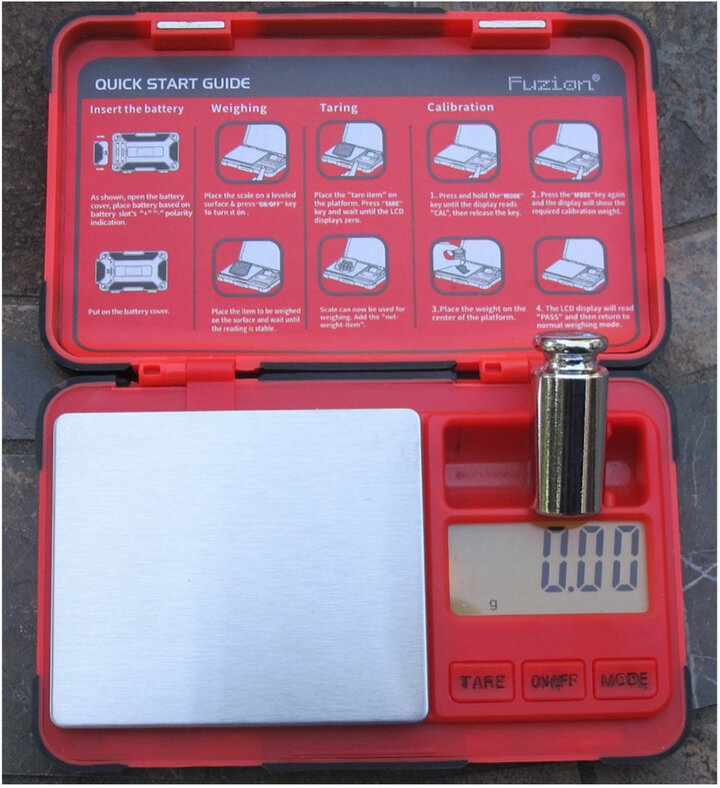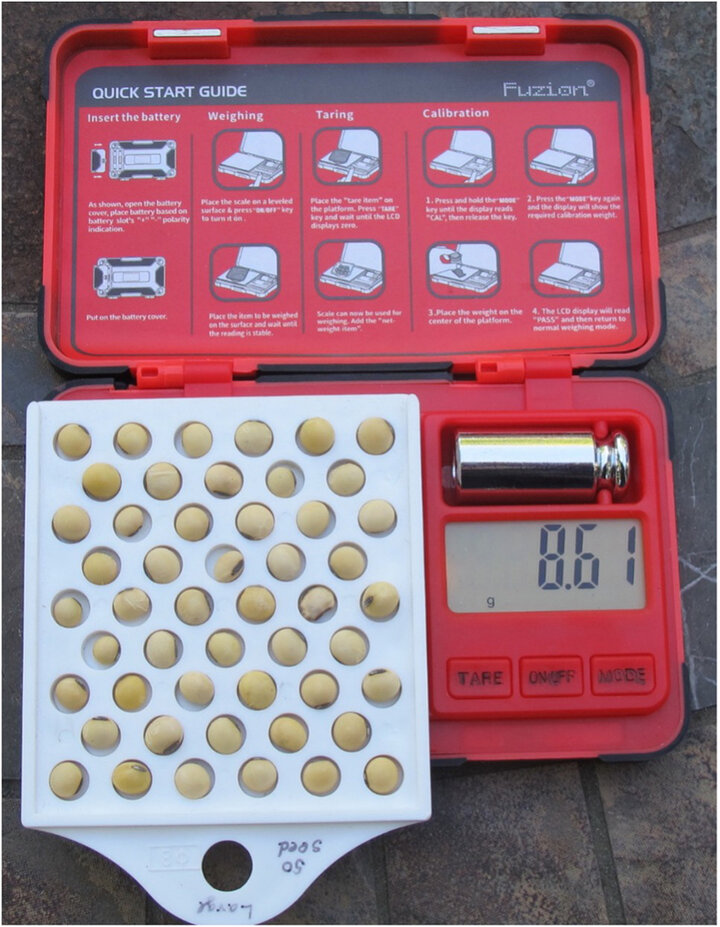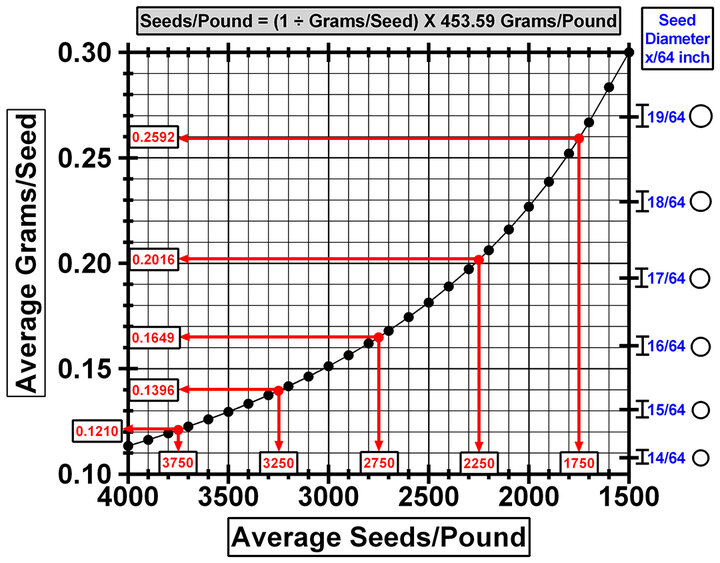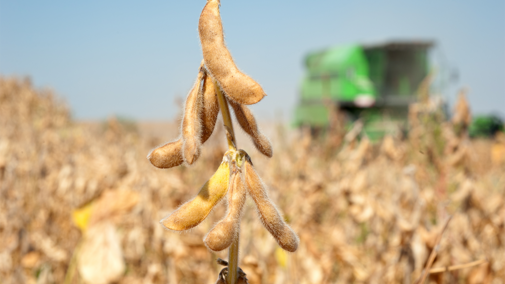Key Points
- Crop water stress during the R5-R7 seed-filling stages can substantially lessen the size (mass weight) of the seeds developing in the pods, thus impacting final yield.
- Seed size comparisons from non-irrigated and irrigated areas pre-harvest can better aid in predicting yields (or in helping explain high/low yields post-harvest).
- Seed size determination can help producers identify planting date, row spacing, and varietal seed size and maturity group options to offset the yield reduction risk relative to the probability of drought.
- This quick method can aid with independent assessments of soybean yield contests.
Soybean seed yield has traditionally been defined as a function of the five factors shown in the below mathematical equation. The 60-pounds-per-bushel factor is the soybean volume-weight standard established by the USDA in 1925.
Equation 1
- Seed Yield (bushels/acre) = [(plants/acre) x (pods/plant) x (seeds/pod)] ÷ [(seeds/pound) x (60 pounds/bushel)]
The use of this equation to generate pre-harvest yield estimates has been described in extension publications (e.g., Lee and Herbek, 2005; Licht, 2023). Late in the reproductive period, field-representative plant stand counts can be taken to estimate final plant population. Then, a random sample of plants can be collected to obtain an estimate of pods/plant. Although pods could be count-sorted into one-, two-, three- and four-cavity pod categories, this is rarely done; instead, a value of 2.5 seeds/pod has been found to be a useful rule-of-thumb number for this factor.
The seeds/pound factor is not truly measurable until all pods and seeds therein attain full physiological maturity. Its final value will be dependent not only on the soybean variety, but also on the weather that prevailed during reproductive development. The number of seeds per pound is printed on the tag of a bag of varietal seed and could be input into the equation, but that value may need adjusted upward or downward to reflect the producer’s perception of the degree to which weather has (so far) enhanced or depressed final seed size. Making weather-related adjustments of a varietal seeds/pound value is not unusual, given that most seed variety catalogues show a +/- 300-seed range around the centric mean seeds/pound value for the seed lots of varieties that will be offered for sale each spring.
Producers are now harvesting their 2023 soybean crop fields, and thus may be keenly interested in how their pre-harvest yield estimates compare with post-harvest reality. Sad to say, but their combine yield monitors are likely displaying the impact of the 2023 growing season weather pattern — which was mostly wet/cool in July during the seed number setting stages of R1-R2 (flowering) and R3-R4 (podding), but then was mostly dry/hot in August during the seed mass setting stages of R5-R7 (seed-filling). This 2023 weather pattern has resulted in a reduction in the size of the harvested seeds, which means that more (small) seed will be required per pound. This impact is not unexpected, based on prior research (see the companion CropWatch article).
Using a Condensed Yield Equation for a Post-Harvest Yield Component Analysis
Soybean seed yield is ultimately a function of just these two key components: (a) the number of seeds harvested per unit of area, and (b) the number of seeds per unit of mass weight. Here, we condense the foregoing equation to create a more simplified biophysical equation that producers can use in a post-harvest yield component analysis:
Equation 2
- Seed Yield (bushels/acre) = [(Seeds/square foot) x (43,560 square feet/acre)] ÷ [(Seeds/pound) x (60 pounds/bushel)]
An intrinsic property of this equation is the n-1 degrees of freedom, a term that comes into play if values are measurably estimated for any two of the three equation variables, then the value for the other variable is instantly knowable (via rearrangement of the equation). This is evident in Table 1. The left column in that table displays vertically arrayed data cells whose values range from 100 to 500 harvested seeds/square foot of ground area. The horizontal row across the top of that table displays data cells whose values range from 4,000 to 1,500 seeds/pound (i.e., from small to large seed). The body of the table displays soybean seed yield data cells, wherein each has a value derivable from the intersection of a left column data cell with a top row data cell.
To use this table, the reader moves downward from any top-row seed mass weight value (e.g., 2,750 seeds/pound), and rightward from any left-column seed number value (e.g., 300 seeds/square foot) to converge on an intersecting table-body seed yield value (e.g., 79.2 bushels/acre).
Next, let us assume that your soybean yield was 58.1 bushels/acre. That yield could have been obtained from the harvest of 320 seeds/square foot, but only if the seed mass was also 4,000 seeds/pound (very small seeds). Alternatively, if you had a seed mass of 1,500 seeds/pound (very large seeds), the seed yield could still be 58.1 bushels/acre, but only if you had harvested 120 seeds/square foot.
Readers will likely note the diagonally arrayed set of grey-highlighted yield data cells, all of which contain an identical 58.1 bushels/acre. This is because each of those identical yield data cells arise from a biophysically constrained combination of a specific top-row seeds/pound value and a specific left-column seeds/square foot value.

To convert x grams per seed into y seeds per pound, invert x value (1/x), then multiply by 453.59 grams per pound. Example: [1 ÷ 0.1649 grams per seed] = 6.064 seeds per gram x 453.59 grams per pound = 2,750 seeds per pound.
To adjust x seeds per pound at a zz% seed moisture to get y seeds per pound at a market standard 13% seed moisture, multiply x seeds per pound at zz% moisture by [(100-zz) ÷ 87] to adjust seed number per pound to 13% seed moisture. Example: If zz% = 15%, then: (2,815 seeds per pound at 15%) x [(100-15) ÷ 87] = 2,750 seeds per pound at 13%.
If you know the field plant population, divide x plants per acre by 43,560 square feet per acre to get y plants per square foot. Then, divide the seeds per square foot value for that field (i.e., left table column cell) by y plants per square foot to get an average number of seeds produced per plant in the field. Assume you had 100,000 mature plants per acre. Example: 300 seeds/sq ft ÷ [100,000 plants/acre ÷ 43,560 sq ft/acre] = 131 seeds produced per plant in the field.
*Note: If you collect 10 consecutive plants from a row in your field, you can count the total number of pods present on the 10 stems and branches. Then divide that stem+branch pod total by 10 to get an average pod number per plant. Example: Assume you did this 10-plant pod count and found an average of 52 pods per plant. Assuming a 131 seed per plant value shown in the prior example, then 131 seed per plant divided by 52 pods per plant = 2.50 seeds per pod.
A Post-harvest Protocol for Assessing the Seeds/Pound Component of Seed Yield
So, how can soybean producers conveniently and quickly measure the post-harvest seed mass yield component shown in the above yield equation? Here, we provide readers with a protocol for measuring seed mass in a seed sample collected from their combine hopper to assess that yield component’s contribution to the bushel/acre yield values that the yield monitor was displaying at the time the sample was collected. Obviously, a remote on-the-go measurement would be useful for those who want a quick answer, though others will want to wait until multiple seed samples are randomly collected from across the entire field and a final field yield value has been determined.
Note that in Table 1, just above the row of seeds/pound data cells is a row of data cells containing the corresponding matching values of grams/seed. That correspondence is based on a grams-to-pounds equivalency constant shown in the last term of this equation:
Equation 3
- Seeds/pound = [(1 ÷ grams/seed) x (453.59 grams/pound)]
It is thus not necessary for a soybean producer to collect at least a pound of seed from the combine bin, and then take the time to tediously count the thousands of seeds present in that sample pound. Instead, one can simply use a 50- or 100-hole seed counting plate to draw random sets of seeds from a harvested seed sample, and then obtain gram weights from at least three (or more) randomly drawn replicate seed count sets. After averaging those gram weights, the average can then be divided by the 50 or 100 seed counts to compute an average grams/seed value, which in turn can be converted to an average seeds/pound value, as shown in the above equation.
Soybean producers can apply the foregoing simplified seed count-gram weight protocol for estimating seeds/pound by acquiring these mostly inexpensive items:
- A pocket-sized digital mini-balance capable of weighing up to 200 grams with a precision of at least 0.1 or preferably 0.05 grams; preferably one that has a lid cover for travel portability and includes a 50-gram weight for user-mediated calibration purposes (currently available online at about $15 from many companies).
- A lightweight 50-hole counting plate that can be easily tared on the mini-balance before randomly drawing a sample of 50 soybean seeds to weigh (available at about $2 each from online hobby stores offering bead-size hole counters that can be easily used to count soybean seed),
- Several quart-size plastic bags with slider-type sealable tops to use when collecting seed from combine bins during harvest; bag closure ensures that combine harvest seed moisture content is maintained in the collected seed sample until seed count-weighing protocol can be done (available at about $0.20 each from grocery stores).
- A lightweight plastic bowl and a ¼ cup kitchen tool to hold and manipulate soybean seed when working to draw random sets of 50-seed count samples (available at about $1 each from department stores).









Figure 1 shows a graphical depiction of the inverse relationship between various grams/seed values on the left vertical Y-axis and the corresponding seeds/pound values on the bottom horizontal X-axis. For example, the four red data symbols displaying the horizontal and vertical arrows depict four specific corresponding left and bottom axis pairs of grams/seed and seeds/pound values.

In a similar manner, readers who have measured an average grams/seed value for a given field soybean seed sample can simply draw an eyeballed imaginary horizontal line across the graph to the nearest black data symbol and from that symbol, draw an eyeballed imaginary vertical line downward to the corresponding imputed average seeds/pound value.
Also note that on the right vertical Y-axis are shown numerical seed diameters (expressed in x/64th inch units used in commercial round-hole soybean sieve screens) that correspond to the grams/seed values shown directly across the graph on the left Y-axis. This correspondence relies on the assumption that the near-spherical soybean seeds have a volume density that is known to average nowadays about 1.2 grams/cubic centimeter based on commonly occurring U.S. soybean seed contents of protein, oil, carbohydrate and water (for 13% moisture seeds). Clearly, soybean seed diameter and circumference (shown in scale as bars and circles along the right Y-axis) is larger the higher the value of the grams/seed value, for which there will be larger, but fewer, seed numbers in the corresponding seeds/pound value.
So, what is the value to the soybean producer of being able to easily measure seeds/pound?
As noted above, drought in August can lead to crop water stress during the R5-R7 seed-filling stages that can substantially lessen the size (mass weight) of the seeds developing in the pods because of a slow-down and possibly early shutdown of photosynthetic seed dry matter accumulation prior to normal crop maturation. Producers who have center-pivot irrigation fields in which the four corners are not irrigated can measure the seeds/pound parameter in seed samples collected inside the irrigated pivot area and in rainfed corners to assess the degree to which an August drought-induced reduction in seeds/pound contributed to the irrigated versus rainfed yield differential. Such comparisons can help producers identify planting date, row spacing, and varietal seed size and maturity group options that might help offset the yield reduction risk relative to the probability of drought occurrence for rainfed soybean production in their regions.
Finally, extension specialists who are asked to serve as soybean yield contest judges might consider making a seeds/pound assessment in yield contest fields.
For example, consider the case of the Georgia producer who, in 2023, reported a record soybean yield of 206.8 bushels/acre and suggested that the harvested seed in field likely had a seed mass of ~1,675 seeds/pound (Bennet, 2003). A simple rearrangement of Equation 2 shows that those two reported field-average values are biophysically plausible only if the average number of seed produced/harvested in that field was ~477 seeds/square foot. The producer stated that the final plant population was 77,000 plants/acre, which when divided by 43,560 square feet/acre is 1.7677 plants/square foot, and dividing that value into the 477 seeds/square foot value indicates ~270 seeds/plant. Dividing that by (the foregoing rule-of-thumb) 2.50 seeds/pod value would infer a field average of ~108 pods/plant. Clearly, soybean yield contest judges using a portable seed mass measurement kit can independently report a yield component analysis of soybean yield contest fields.
References
Lee, C. and Herbek, J. 2005. Estimating soybean yield. AGR-188. University of Kentucky. Cooperative Extension Service. https://www2.ca.uky.edu/agcomm/pubs/agr/agr188/agr188.pdf
Licht, M. 2023. Soybean yield estimates. Iowa State University. Extension and Outreach. https://crops.extension.iastate.edu/encyclopedia/soybean-yield-estimates
Bennet, Chris. 2023. Young Farmer Breaks Soybean World Record With a Stunning 206-Bushel Yield. AgWeb. https://www.agweb.com/news/crops/soybeans/young-farmer-breaks-soybean-world-record-stunning-206-bushel-yield

